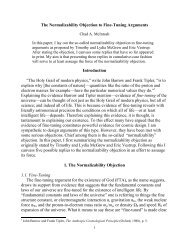Theism and Explanation - Appeared-to-Blogly
Theism and Explanation - Appeared-to-Blogly
Theism and Explanation - Appeared-to-Blogly
Create successful ePaper yourself
Turn your PDF publications into a flip-book with our unique Google optimized e-Paper software.
Potential Theistic <strong>Explanation</strong>s 79<br />
open <strong>to</strong> a divine agent. Since I have yet <strong>to</strong> discuss the role of modal judgements<br />
in proposed theistic explanations, I shall examine this form of the<br />
sceptical objection later, under the heading of “modal scepticism” (5.4.3).<br />
But the outcome of each of these two forms of scepti cism—theological <strong>and</strong><br />
modal—is the same. If we cannot make such judgements, then the in principle<br />
objection is correct: an account of divine action cannot be even a<br />
potential explanation, of any state of affairs. End of s<strong>to</strong>ry.<br />
5.1.1 Design Arguments<br />
A contemporary expression of theological scepticism can be found in the<br />
work of Elliot Sober. Sober employs his theological scepticism in order <strong>to</strong><br />
argue against intelligent design theory. But his sceptical objections are applicable<br />
<strong>to</strong> any kind of proposed theistic explanation. So his arguments against<br />
intelligent design will make a useful starting point for my discussion.<br />
Like Robin Collins <strong>and</strong> Richard Swinburne (2.1.3.1), Sober makes use of<br />
confi rmation theory in order <strong>to</strong> analyse the theist’s arguments. He argues<br />
that the design argument is most plausibly unders<strong>to</strong>od <strong>to</strong> rely on the “likelihood<br />
principle.” This principle reads:<br />
Observation O supports hypothesis H 1 more than it supports hypothesis<br />
H 2 if <strong>and</strong> only if Pr(O|H 1 ) > Pr(O|H 2 ). 4<br />
In most forms of design argument, hypothesis one (H 1 ) is assumed <strong>to</strong> be<br />
design <strong>and</strong> hypothesis two (H 2 ) is thought <strong>to</strong> be chance. One might, of<br />
course, argue that chance is not the only alternative <strong>to</strong> design. Since 1859<br />
we have had an alternative, at least in the case of biological systems, namely<br />
natural selection. But the advocates of intelligent design (against whom<br />
Sober is writing) argue that the Darwinian hypothesis cannot do the job,<br />
that it is not even a potential explanation of the complexity <strong>and</strong> diversity<br />
of living organisms. This, they believe, justifi es their view that the only<br />
alternative is chance. 5 So if O represents the observed fact, C represents the<br />
chance hypothesis, <strong>and</strong> D represents design, their argument rests on the<br />
following claim:<br />
Pr(O|D) > Pr(O|C).<br />
In other words, they argue that the observed facts are more likely given the<br />
hypothesis of design than given what they regard as the only alternative,<br />
namely chance.<br />
5.1.2 No Vic<strong>to</strong>ry by Default<br />
Sober’s response <strong>to</strong> this claim makes two points. First of all, he argues that<br />
the design hypothesis (if it is a hypothesis) does not win by default. To claim<br />
vic<strong>to</strong>ry for a design hypothesis, it is not enough <strong>to</strong> show that Pr(O|C) is very



